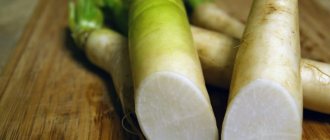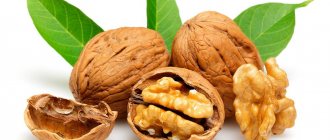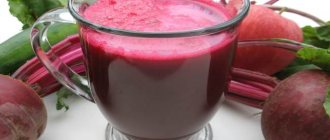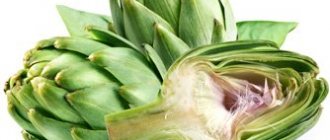Among the abundance of foreign vegetable delights, such as broccoli, celery or asparagus, we have completely forgotten about the traditional products characteristic of our culinary tradition. One of our grandmothers’ favorite vegetables is radish. It migrated to us from Asia, and today it is cultivated throughout Europe and has even reached the USA.
Black radish is considered especially popular. It is the most useful and ambiguous in terms of taste and aroma. Why has this absolutely unpleasant vegetable gained popularity not only in the culinary, but also in the medical sphere?
General characteristics of the product
Radish is a biennial herbaceous plant. Species – radish, family – cabbage.
Name Features
Content:
- General characteristics of the product
- Useful properties of the ingredient
- Use of the ingredient in cooking
- Additional uses of the ingredient
- Contraindications for use of the product
- Rules for collecting and storing vegetables
The word "radish" is used both to designate the whole genus of plants Raphanus, and for its individual seed variety. In European and Asian territories, they prefer to call the vegetable “daikon”. The flexible Slavic languages adopted several names: daikon, radish, radish and loba.
Territorial distribution and ecological features
Radish roots are woven into Asian regions, where the crop has long been grown as a staple forage vegetable. A feature of the plant is its unique unpretentiousness. Radish takes root in almost any area and can withstand any climatic difficulties. The plant does not run wild at all, therefore it is cultivated in Asia (temperate climate zone), Europe and the USA.
Black radish is especially pleased with deep, humus and slightly moist soil. In such conditions, the plant will develop as quickly as possible and produce a bountiful harvest.
Black radish has many enemies, including fleas and various types of mushrooms. Without human intervention, the parasites simply eat the plant at the root.
To protect radishes, you need to carefully select and fertilize the soil, monitor the condition of the plantings and spray them with special solutions.
Botanical description
The root is the only part of the plant that is eaten. As the radish grows, it thickens, becomes saturated with juices and seems to swell. Initially, the color of the root is neutral, but as it matures it turns black.
The leaves are lightly chopped and take on a lyre-shaped shape. The upper blade is large, the lower leaves become smaller as they approach the ground. The radish produces about 2-5 pairs of lateral lobes, which later form beautiful flowers of a pastel palette.
The plant's pods are wide and swell and become limp as they develop. The insides are spongy with indistinct cavities.
Useful properties of the ingredient
Among herbal remedies like honey, garlic or ginger, black radish stands out. Its disinfecting and bactericidal properties come to the fore. Pieces of vegetables, after getting inside, literally cleanse surfaces and mucous membranes of harmful microflora. The antibacterial effect is provided by the essential oils that make up the vegetable.
100 grams of dried black radish contains 50 milligrams of essential oils.
Another important component is glycosides. These substances block poisons, stimulate cardiac activity and are responsible for the specific bitter taste and spicy aroma of radish.
The vegetable concentrates vegetable protein, carbohydrates, fructose, fat, vitamins and nutrients. Due to them, radish accelerates metabolic processes, strengthens the protective functions of the immune system, and removes excess fluid from the body (additional prevention of urolithiasis). Agronomists call black radish a “local antibiotic.” The vegetable really affects most body systems and has a special medicinal and preventive effect.
Scientists have identified lysozyme in the cabbage plant. The component dissolves the walls of harmful cells. Even whooping cough, mycobacteria, Staphylococcus aureus, streptococcus, and diphtheria bacillus cannot resist the indestructible power of lysozyme.
Plant enzymes dissolve toxins and other pathogenic elements in the bile ducts and gallbladder. The pulp creates a special barrier for germs and harmful microorganisms, which protects mucous membranes and prevents disease.
Doctors recommend introducing black radish into the diet of patients with high salt concentrations and problems with the gallbladder.
It is necessary to extract juice from the vegetable, which is used as a choleretic agent. Moreover, due to Potassium (K), the vegetable stabilizes the water-salt balance. Such a herbal replacement for classical medications is only permissible if the patient does not feel pain. If pain is present, then you need to abandon untested methods and strictly follow the doctor’s recommendations. Chemical composition of the ingredient
| Nutritional value (per 100 grams of unprocessed vegetable) | |
| Calorie content | 36 kcal |
| Squirrels | 1.9 g |
| Fats | 0.2 g |
| Carbohydrates | 6.7 g |
| Alimentary fiber | 2.1 g |
| Water | 88 g |
| Ash | 1 g |
| Vitamin composition (in milligrams per 100 grams of unprocessed vegetable) | |
| Retinol (A) | 0,003 |
| Beta-carotene (A) | 0,002 |
| Thiamine (B1) | 0,003 |
| Riboflavin (B2) | 0,003 |
| Niacin (B3) | 0,003 |
| Pantothenic acid (B5) | 0,18 |
| Pyridoxine (B6) | 0,06 |
| Ascorbic acid (C) | 29 |
| Tocopherol (E) | 0,1 |
| Nicotinic acid (PP) | 0,6 |
| Nutrient balance (macro and microelements in milligrams per 100 grams of unprocessed vegetable) | |
| Potassium (K) | 357 |
| Calcium (Ca) | 35 |
| Magnesium (Mg) | 22 |
| Sodium (Na) | 13 |
| Phosphorus (P) | 26 |
| Iron (Fe) | 1,2 |
Benefits of black radish juice
The drink obtained from the vegetable eliminates the inflammatory process in the internal organs. Removes harmful compounds from the cavity. The action of antioxidants makes the skin beautiful and completely rejuvenates the entire body. The person feels more energetic and healthier.
Radish juice is beneficial for people who suffer from slow metabolism, as a result of which they gain excess weight. Drinking red juice accelerates the secretion of gastric juice. A person gains a full appetite. All together leads to the normalization of the digestive process.
First of all, red juice should be taken by people who have been diagnosed with cirrhosis of the liver, cough or bronchitis. An indication for the use of black root vegetables is also chronic hepatitis. Regular consumption of the drink eliminates the symptoms of the disease. To achieve maximum effect, it is recommended to take only fresh juice.
Use of the ingredient in cooking
Behind the unattractive appearance of the vegetable lies a real gastronomic discovery. In addition to its medicinal benefits, radish has many different flavors and uses.
Cut out the core of the vegetable, wash it thoroughly and fill it with your favorite honey. Such a simple but incredibly tasty dish will not only tantalize your taste buds, but also protect you from many diseases. The combination of sweet, viscous honey with sour-bitter radish is simply impossible to describe in words, it’s better to try it once. Moreover, honey infused with radish doubles its medicinal potential.
The white crispy pulp, which combines absolutely all possible flavors (from sour to sweet), is similar to a mixture of radishes, horseradish, turnips and honey candies. What to cook with black radish:
- soup;
- vegetable broth;
- salad;
- sauce/marinade;
- vegetable chips;
- baked snack;
- sweetness (using honey and all kinds of sweeteners);
- boiled first course.
If you can’t choose a processing method, then just put potatoes in place of the radishes. All the manipulations that you carry out with a root vegetable can be carried out with a bittersweet vegetable.
Radish salad recipe
We will need:
- black radish – 300 g;
- green radish – 300 g;
- celery root – 80 g;
- pomegranate – 100 g;
- hard cheese – 100 g;
- lemon – 50 g;
- balsamic vinegar – ½ teaspoon;
- vegetable oils to taste (we recommend mixing 2 vegetable oils to enhance the taste);
- greens to taste;
- spices to taste.
Preparation
Grind the radish into thin slices, and grate the celery on a coarse grater. Finely chop the greens and remove the seeds from the pomegranate. Squeeze lemon juice, mix in a convenient container with balsamic vinegar, then add 2 types of vegetable oils.
Choose unusual combinations of oils (for example, olive and truffle or cottonseed and grape) to prepare not just another vegetable salad, but an exquisite restaurant dish with a whole palette of flavors.
Add chopped herbs and your favorite spices to a mixture of juice, balsamic vinegar and oils. Add chopped radish and celery to the prepared sauce, mix thoroughly until the sauce completely covers the vegetables.
Place the prepared salad on a plate, sprinkle with pomegranate seeds and large pieces of hard cheese on top (you can grate it on a fine grater if desired).
Use in folk medicine
For sinusitis
- 200 g fresh radish puree.
- 200 g flour.
- 80 g of warmed honey.
- mix all;
- Make flat cakes from the resulting mass;
- and apply them to the area of the maxillary sinuses for ten minutes.
If the burning sensation is severe, the procedure time can be reduced to five minutes.
Against cough
- 1 black radish fruit.
- 2 tbsp. spoons of honey.
You can eliminate a cough with a tincture of radish and honey.
- Cut off the top of the fruit and cut out part of the pulp.
- Then we put honey inside and cover with the cut off top.
- The infusion should be kept for at least 6 hours, after which you should drink the resulting elixir 1 teaspoon before meals.
The tincture effectively strengthens the body and increases its resistance to various colds, and also facilitates the discharge of phlegm.
For hair
1 black radish fruit.
To combat brittle and weak hair, as well as to give it a healthy shine, you can prepare an effective mask. For this:
- take a large black radish, peel it and grind it in a blender or meat grinder;
- filter the pulp through a cloth and get juice;
- Rub this concentrate into the hair roots an hour before water treatments.
After some time, a burning sensation will appear. But don't be scared, this is normal. If you feel discomfort, you can wash off the mask with warm water. The session should be held for a month .
For the liver
200-300 g black radish.
- Grate or mince the vegetable.
- Squeeze out the juice.
- Then we take it three times a day, 30 ml. gradually increasing the dosage to 60-100 ml.
Treatment is carried out for two months . After some time, the course can be repeated.
For colds
- 1 large black radish.
- 100 g honey.
- Grate the radish and mix with honey, then put it in the refrigerator for 10 hours to allow the mixture to infuse.
- After the time has passed, squeeze out the pulp.
Take the drug five times a day, 1 tablespoon.
For hemorrhoids
- 200-300 g black radish.
- 30 ml vegetable oil.
- Grate the radish.
- Mix with oil.
This remedy should be taken 60 g two or three times before meals for 14 days.
For hoarseness of voice
- 200-300 g black radish.
- 2-3 tbsp. spoons of honey.
- Take a black radish and cut the top, make a hole in the pulp, and then pour honey into it.
- Cut off half at the root and place in a deep cup or pan. After an hour, the vegetable will begin to produce juice, and it will accumulate in the dishes.
Take half a teaspoon of the product as the required amount appears.
For cholecystitis
1 black radish fruit.
- Three or mince the fruit.
- Squeeze the mass through the fabric.
The resulting black radish juice should be drunk before each meal , a tablespoon every day. The treatment period is two weeks.
For hypertension
200-300 g black radish.- 1-2 tablespoons of sugar.
- Cut the vegetable into small cubes and sprinkle granulated sugar on top.
- Next, wait until the black radish releases its juice.
The tincture should be taken one tbsp. l. during the week thirty minutes before meals.
All of the listed treatment methods can only be used as an additional treatment to that prescribed by a doctor. When using black radish to treat diseases, you should be careful, as the consequences can be serious. Therefore, it is recommended to promptly seek help from a specialist.
This healthy vegetable can be grown independently in the garden or in a greenhouse. Read our articles about the timing and nuances of planting, as well as about the variety of black winter radish.
Additional uses of the ingredient
Industry and cosmetology
Industrial cultivation of black radish is advantageous in terms of ease of care and high yield. Industrial cultivation is practiced in areas with cool climates. This is where the radish takes root best, releasing the maximum amount of oil. Essential oil is the main product targeted by the food/medicinal and cosmetic industries.
Radish essential oil can be used as biofuel.
Culture
Black radish has been able to find its niche not only in medicine or cooking, but also in popular culture. On December 23, an annual festival called “Night of the Radish” takes place in Mexico (Oaxaca de Juarez). The festival takes place as part of a popular national holiday, so it covers a huge number of people (both local people and visitors or tourists).
On “Night of the Radish,” people carve various figures from the black fruit. The type of figurine depends solely on the author’s imagination.
Radishes are transformed into biblical heroes, cartoon characters, ordinary household objects or futuristic works of art. Worthy works are put on public display in the town square.
Contraindications for use of the product
The beneficial properties of the vegetable can become a real trigger for many diseases of the gastrointestinal tract. Excessive consumption of radish is fraught with exacerbation of pathologies that are in remission. Patients with gastrointestinal problems are usually aware of the pathology, and their eating habits are corrected with a preventive diet. In this case, the introduction of any new component should be supervised by the attending physician.
If health problems do not bother you, and your taste buds react positively to radish, then freely introduce the vegetable into your daily diet. Don't forget about the dosage and balance of nutrients: 50-70 grams of cabbage plant will be enough.
Harm of black radish
Although the black root vegetable has many benefits, it should be used with caution. According to contraindications, you should not eat in the following cases:
- heart disease;
- gastritis with high acidity;
- toxic goiter;
- peptic ulcer;
- liver and kidney diseases.
Radish is included in the diet gradually. If you constantly eat vegetables in their pure form, this can negatively affect the gastrointestinal tract. The product should not be taken by people suffering from allergies. Otherwise, the body's reaction can lead to disastrous consequences.
Rules for collecting and storing vegetables
The later the harvest is harvested, the better it will ripen and be saturated with beneficial nutrients. Moreover, agronomists have proven that late harvest guarantees maximum shelf life. Harvest black radishes in late fall (it's important to do it before the first snow falls and temperatures begin to drop rapidly). Sort vegetables immediately after harvesting, without leaving the garden bed. Too small or, on the contrary, gigantic, rotten, infected, frozen fruits will have to be thrown away. Any dent or scratch on the radish reduces the shelf life of the vegetable, impairs the taste and nutritional composition.
If you plan to consume black radish 5-7 days in advance, then place them in any convenient container/craft/bag and put them in the refrigerator. The temperature of the refrigerator compartment should not exceed 0°C. For long-term storage, you will have to carry out a number of simple manipulations. Distribute the vegetables into suitable containers/bags/boxes and lightly sprinkle with soil. The shelf life of radish is 14 days.
Most often, the method is used when transporting whole crops to retail outlets.
The shelf life can be increased by changing conditions and microclimate. In dry rooms with a humidity of about 85% (basements), radishes can be stored for up to 9 months. The shelf life of black radish is much longer than that of other varieties, which adds an additional 30-60 days.
Best materials of the month
- Coronaviruses: SARS-CoV-2 (COVID-19)
- Antibiotics for the prevention and treatment of COVID-19: how effective are they?
- The most common "office" diseases
- Does vodka kill coronavirus?
- How to stay alive on our roads?
If you don’t have a cellar, then don’t despair, just send bags/boxes of vegetables to the balcony. The main thing is that the container with radishes is hermetically sealed, and that the balcony does not blow through and does not allow moisture/ultraviolet to pass through. Find or install a nook where the temperature will be 0°C and enjoy your favorite black radishes for several seasons.
Commodity neighborhood
The aroma, taste, composition and shelf life of radish depend on the correct product proximity. “Place” black radish together with other vegetables that do not have a pronounced aroma. This way we will protect the radish from foreign odors and will not violate the shelf life. The vegetable gets along best with carrots and seasonal potatoes. Store vegetables in a separate compartment or dedicate them to the bottom shelf of the refrigerator.
More fresh and relevant information about health on our Telegram channel. Subscribe: https://t.me/foodandhealthru
We will be grateful if you use the buttons:











